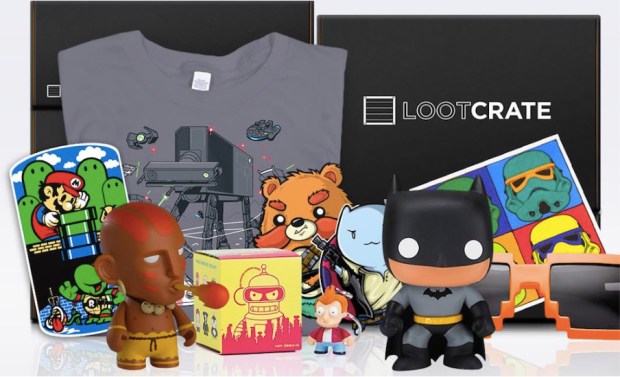Finding The Right Loot For A Rarified Audience

They say it’s the golden era of the American geek. There’s a new Star Wars scheduled to be released every year between now and the end of eternity, super hero movies are now the fall alternative to the ponderous think pieces that seek out Academy Awards and streaming services exist to feed the geek need for media.
And, in an environment where geek taste is ascendant, there is Loot Crate, the subscription service meant to keep geeks well-supplied with the nerdy memorabilia and specialty items they crave.
Since 2012, Loot Crate has been living up to its name by packing monthly — or bimonthly — subscription boxes with action figures, collectables, comic books, clothes and various other bits of dork schwag, themed to the particular taste of each connoisseur.
But how to pack the subscription boxes — particularly given the rather mercurial nature of dorky tastes — and how to avoid the risk of angering Star Wars fans with Star Trek stuff (and vice versa) and how to balance the needs of the Harry Potter fans and the Halo devotees?
Practice, Loot Crate’s Brand Director, Ellen Deng, is the first part of the answer.
“We send out over 600,000 crates a month,” she said. “I mean, a lot of them are monthly crates, so we are shipping them monthly. A lot of them are bimonthly, so we’re shipping them every other month. It all nets out to be a lot, basically.”
The second part of the answer involves a genuine love of what they do and an acknowledgment of the good they bring to other superfans in their community of shoppers.
“At the end of the day, what drives our service is that we are for fans by fans,” Deng explained. “It’s always about the customer, and we are ourselves the customer in many ways, so we keep that in mind every time we put together a product. We deliver a certain experience. All of that plays into our consideration when it comes to curation.”
Customers don’t just open the boxes looking for stuff. After all, it’s an experience, specifically the experience of being nearer to the good things they love in a forum that used to only exist at the various “cons” held nationwide.
“The vision behind Loot Crate was we wanted to bring the Comic Con experience directly to your doorstep,” said Deng. “Comic Con isn’t just the consumer products that you’re buying. It’s about being here and feeling that excitement. There’s so many … things that we try to do to infuse that experience within the community.”
Which means the team has to be avid pop culture denizens to stay on trend and ahead of the retail experience their subscribers are seeking. That job is admittedly not too bad — particularly for a collection of self-professed geeks who probably pay very close attention to pop culture anyway, purely for the love of the game.
But, Deng noted, they also look to the subscriber community themselves, particularly their superusers, who they affectionately call “Looters.”
“We call our community Looters because that’s what they call themselves, to be honest,” Deng explained. “That’s what they branded themselves.”
The company is constantly polling their customer base to determine what to be on the lookout for. Which franchises are currently popular? Loot Crate pays attention to the places that Looters interact with one another: on Twitter, Facebook and even on the company’s Reddit channel. “[Our community is] a really big part of our consideration set when we think about what franchises, what kind of products to put in a crate,” Deng said.
Which can be a challenge: Crates are designed well in advance of set-up — six to eight months can go into the boxes — but, Deng noted, they have to be ready for those things that explode in pop culture, because fans aren’t waiting half a year to catch up to the culture.
“Sometimes we have to be very nimble about our timelines as well so that we can make sure we’re delivering something at the right time.”
To build those coveted boxes filled with diverse memorabilia and action figure collectables, the team works with 200 licenses to deliver brands and retail products in which their Looters are interested. They also work directly with partners to develop and secure products for their boxes.
“But if we feel like there’s an opportunity for us to create something new on our own — and that’s what our fans are looking for, something new and innovative in a different kind of way — then we can also have the flexibility of doing that,” Deng said.
The company, she said, also has a “new initiative of turning the crate inside out into something and transforming it so that it’s not just a box anymore.”
